The Fertilizer Mistake That Could Prevent Marigolds From Flowering
Marigolds are a very popular ornamental, bringing a welcome burst of color to summer and autumn gardens, but like any flower, they can have issues, including sparse or lackluster blooms. Failure to bloom is one of the common issues to know about before growing marigolds, but that doesn't make it any less frustrating. When a flower bed looks like it's struggling to bloom, any gardener's first response may be to give the plants a boost with fertilizer, but applying too much fertilizer to your marigolds can easily backfire. Marigolds are low-feeders, which means that once established, they do not require an abundance of nutrients to thrive. In fact, overwhelming them with too many nutrients is likely to do more harm than good. Using too much fertilizer — and especially the wrong kind — can cause marigolds to devote all of their energy into forming lush, green leaves. This might sound like a good thing, but the plant will also produce fewer flowers as a result.
In general, marigolds will actually thrive best in moderately fertile soil. If your soil is naturally quite rich, you should definitely avoid adding fertilizer to your gardening routine, and even if the soil is poor, your marigolds may only need an occasional light boost. Here's how you should be fertilizing your marigolds if needed and the best types of fertilizer to use to encourage magnificent marigold blooms.
Marigolds need a low-nitrogen fertilizer, if any
If your soil is very poor quality, it can be okay to fertilize your marigolds, but the fertilizer should have equal parts nitrogen, phosphorous, and potassium. At the very least, you should avoid products with high nitrogen content. While nitrogen is good for encouraging big leaves, too much can lead to overgrowth. Instead, your fertilizer needs higher phosphorous to help the plant develop its flowers. Potassium is also good to ensure the marigolds won't become stressed or dehydrated during the period of rapid growth. For the best results, opt for a slow-releasing granular fertilizer added to the pot or incorporated into the soil at the time of planting. After planting your marigolds, don't fertilize them again during their growth period.
Alternatively, you can explore more gentle, natural methods for enriching your soil. There are plenty of common household items that can be used as natural fertilizer or to amend the soil before planting. Composted banana peels are an excellent option for marigolds because they contain phosphorous, potassium, and other nutrients but won't contribute nitrogen to your flower bed. In general, growing marigolds should be easy if you avoid common mistakes, and it's important to know that there are other reasons your marigolds may not flower, such as insufficient sunlight, poor drainage, or forgetting to deadhead your old, shriveled blooms.

